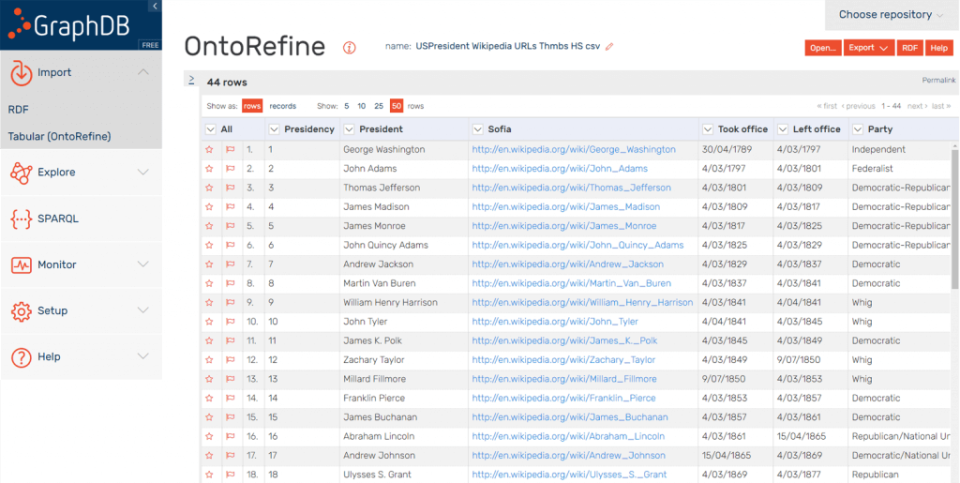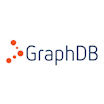GraphDB
About GraphDB
GraphDB Pricing
GraphDB offers a 60-day free trial for new users, after which the software is available across 3 pricing tiers - GraphDB Enterprise, GraphDB Standard, and GraphDB Free on a perpetual license basis. Please contact Ontotext directly for pricing information.
Free trial:
Available
Free version:
Available

Most Helpful Reviews for GraphDB
1 - 5 of 26 Reviews
Stratos
Verified reviewer
Information Services, 11-50 employees
Used daily for more than 2 years
OVERALL RATING:
5
EASE OF USE
5
CUSTOMER SUPPORT
5
FUNCTIONALITY
4
Reviewed December 2023
The best RDF graph database in the market
I have been using GraphDB for several years now and in almost all the positions I have worked for. In my opinion, it is by far the best tool out there for managing RDF graph databases. I love the simplicity of the interface, the practicality and aesthetic superiority of the visualizations and the overal "smoothness" that comes with using it. I cannot stress enough how great the technical support has always been at responding blazingly fast and always providing solutions to various issues one may come accross, even if they are GraphDB Free users.
PROS- Compliance to all the W3C standards, including SHACL. - User-friendly UI. - Aesthetically superior visualizations. - Great documentation: As detailed as it needs to be, but not more than that. - Great technical support (even for the GraphDB Free version users) that responds almost immediately.
CONSI honestly cannot think of anything negative to say about the tool and the customer support. Even though the company behind the tool (Ontotext) is a big global enterprise, every interaction I have with them feels like they genuinely care about whatever issues I am having with GraphDB and honestly want to help out in resolving it.
Mark
Research, 10,000+ employees
Used daily for more than 2 years
OVERALL RATING:
5
EASE OF USE
5
VALUE FOR MONEY
5
CUSTOMER SUPPORT
5
FUNCTIONALITY
4
Reviewed October 2019
Nearly instantaneous, rich-featured semantic repository
There are other triple stores with different feature sets, but it don't think there's any triplestore that is better than GraphDB.
PROSIt's very quick and easy to deploy GraphDB, ingest some RDF data, build queries in a IDE-like environment, and visualize relationships. A semantic similarity search tool is provided.
CONSThe OntoRefine tool is great for converting tabular data files into semantic triples, but there's no support for reading from relational databases. There are nice free text indexing & search tools, but no natural language parser for discovering entities and relationships. There are several pre-configured reasoning levels plus support for writing one's own rules, but no support for SWRL. Like most triplesotres, OWL2 reasoning over complex axioms and millions of data triples isn't fun/fast/realistic? (I say that based on a single node, two threads, and 256 GB RAM.)
Reason for choosing GraphDB
Great SPARQL query building environment. Built in visualizations. Fully functional 2-core version and reasonable academic prices.
Reasons for switching to GraphDB
Easier to deploy and configure. Better SPARQL query building environment. Built in visualizations. GUI for importing tabular data.
Vendor Response
Thank you for your feedback, dear Mark! We will address all the recommendations you have left to the production team. Be well
Replied November 2019
Alexander
Research, 1,001-5,000 employees
Used weekly for less than 12 months
OVERALL RATING:
4
EASE OF USE
4
FUNCTIONALITY
3
Reviewed November 2019
review of graphdb in the production planning
We are currently using graphdb in a PoC as semantic web stack compliant database for data integration in a laboratory environment.
PROS- ease of use (compared to other semantic web stack solutions) - degree of inferencing implementation - solution for transforming relational data into RDF with OpenRefine integration - query performance (for SELECT, a evaluation for INSERT queries could not be given due to use of free version) - good support even at free version
CONS- versioning of data (see changes over time) - better controllability of role and rights (give rights for specific graphs in repository) - no IdP based authentiaction like OpenID Connect (or something based on oAuth2 or at least SAML) - easy to use integration for object storage (like AWS S3) - documentation could be more detailed in some places
Reason for choosing GraphDB
- extensive free version - ease of use (frist time usage of an rdf triplestore / graph database) - visualization - beginner-friendly documentation
Vendor Response
Thank you for your feedback!
Replied November 2019
Nicolas
Research, 10,000+ employees
Used weekly for less than 12 months
OVERALL RATING:
5
EASE OF USE
5
VALUE FOR MONEY
5
CUSTOMER SUPPORT
5
FUNCTIONALITY
5
Reviewed February 2024
GraphDB, an efficient Graph Database
- Easy to use - Fast to deploy - Performant for reasonement - Support most of important things about W3C ontologies
CONS- Some features are restricted for enterprise (example for some access control features) - Expensive if you work alone and need a license for this kind of infrastructure
Joop
Government Administration, 201-500 employees
Used weekly for less than 2 years
OVERALL RATING:
5
EASE OF USE
5
VALUE FOR MONEY
5
FUNCTIONALITY
4
Reviewed November 2019
GraphDB
We use GraphDB together with PoolParty as part of the Semantic Integrator solution. We use GraphDB as our test triple store. We use GraphDB to publish our "small" linked open data sets.
PROSI can be very short about my (our) experiences so far with GraphDB. GraphDB is a clear winner for our usecases now. The learning curve is not steep, almost self-explanatory. It’s fast and it fits our needs; for now. We loved the graphics of GraphDB.
CONSOntoRefine. It looks fine but we missed some modeling features. We switched back to OpenRefine.
Reason for choosing GraphDB
Stardog is very good, but some things, like sharing the databases, adding data were not so straight forward. Stardog had problems with gzip files or any other files than trig.
Reasons for switching to GraphDB
Virtuoso was too big and too complicated for our use.
Vendor Response
Thank you for your feedback, Joop. Be well!
Replied November 2019




